 Véto-pharma
Véto-pharma Yellow-legged hornets (Vespa velutina, also called “Asian hornets” in Europe) pose a significant threat to honeybees, feeding on them voraciously. But beekeepers, fear not! Effective solutions are at hand. Véto-pharma, with years of experience, brings you the perfect trap to counter this menace.
This article is following a first one called “The Unwelcome Guest: Introducing the Yellow-legged Hornet to America”.
You might want to read it before diving into trapping methods!
https://www.blog-veto-pharma.com/en/the-unwelcome-guest-introducing-the-asian-hornet-to-america/
For beekeepers grappling with the Yellow-legged hornet invasion, trapping isn’t just a strategic move—it’s a lifeline. A handful of these hornets can devastate bee colonies in no time. In fact, many beekeepers have come to dread the Asian Hornet even more than the notorious varroa mites.
At its core, trapping is about population control. Each trapped queen in the spring could mean thwarting the emergence of thousands of hornets by summer, offering a protective barrier for our bee colonies. Trapping isn’t merely a reactive measure; it’s also a tool for data collection & monitoring. By studying the trapped hornets, beekeepers and researchers gain insights into their spread, migration patterns, and can adjust protective strategies accordingly.
Lastly, trapping isn’t just about safeguarding our honeybees. It’s a broader effort to maintain ecological balance. The unchecked proliferation of the Yellow-legged hornet poses threats beyond the hives, potentially disrupting local insect populations and thereby the entire ecosystem. For beekeepers, the act of trapping is non-negotiable, a vital defense mechanism against a formidable adversary.
In the world of beekeeping, timing is everything, especially when it comes to combating the Yellow-legged hornet. Trapping strategies are largely defined by two distinct phases: spring and fall. But what sets them apart?
While spring trapping is a proactive measure to curtail the impending hornet surge, summer/fall trapping offers both immediate relief from predation and a long-term reduction strategy. Employing both techniques provides beekeepers with a comprehensive shield, ensuring their hives remain secure all year round.
However, it’s worth noting that spring trapping sometimes faces criticism for its potential impact on biodiversity. Despite this, French beekeepers overwhelmingly advocate for it, emphasizing its vital role in limiting hornet devastation on bee colonies. In France, one association stated that the insect consumption impact of 15 to 20 traps is comparable to that of a single chickadee raising its brood. This serves to underscore the immense toll of hornet predation if we allow queens to establish nests unchecked.
The world of beekeeping is abuzz with inventive methods to outsmart the Yellow-legged hornet and protect our precious bee colonies. From advanced trapping technologies to ingenious DIY solutions, let’s explore the tools beekeepers have in their arsenal.
Before the hornets can even approach a hive, shields play a crucial role. Affixed right at the hive’s entrance, these barriers serve as physical obstructions, making it harder for hornets to gain access and prey on the bees within. By making the hive entrance narrower and more intricate, hornets find it challenging to hover at the entrance and catch bees, effectively reducing their predatory success.
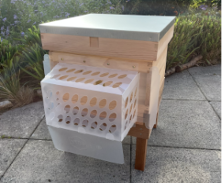
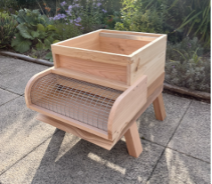
Traps come in various shapes and sizes, ranging from large to small, and from budget-friendly to more expensive options. The type of trap (and the associated liquid attractant) you choose will largely depend on your specific needs and objectives.
“Small traps” – This category includes both DIY bottle traps, which can be modified with special lids, and commercially available traps. While DIY bottle traps, made by repurposing water bottles, are cost-effective, they may not always be the most efficient. A study conducted in France found that the Véto-pharma trap named “VespaCatch” captured nearly twice as many hornets as DIY bottle traps (395 hornets for VespaCatch vs. 213 for bottle traps). There are other traps available that target different species of hornets or wasps, but their design, especially the size of the openings, may differ. VespaCatch is tailored specifically to ensnare the Yellow-legged hornet.
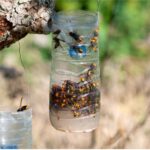
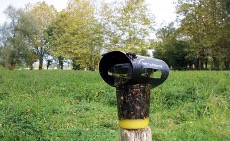
In recent years, larger traps have surfaced. These traps tend to be more selective (allowing smaller insects to escape through a grid) but might be less effective. To illustrate, in the same study mentioned earlier, the Jabeprode® trap caught only 94 hornets, compared to VespaCatch’s 395. When faced with a significant hornet threat, many beekeepers prioritize efficacy over selectivity.
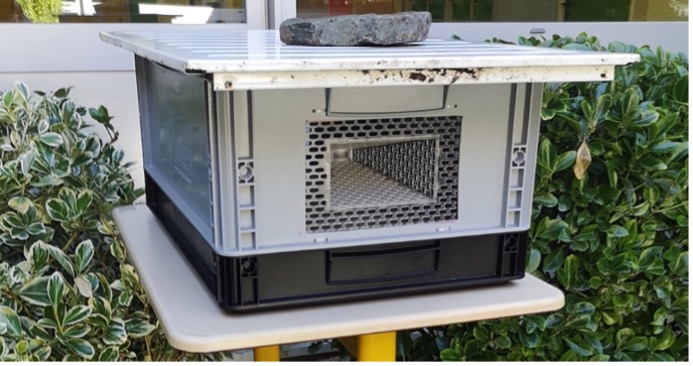
Naturally, the efficacy of these traps also hinges on the quality of the attractant solution used.
The attractant should be aligned with the Yellow-legged hornet’s life cycle:
For the sugar variant, you can either buy a pre-mixed liquid attractant (often paired with a specific trap) or make your own concoction (a blend of beer, white wine, and grenadine). At Véto-pharma, we’ve crafted a distinct attractant for use with the VespaCatch trap, formulated in collaboration with a French association after numerous field tests.
For the protein formulation, beekeepers commonly employ fish such as tuna or salmon, and even shrimp. If you’d rather save the finer seafood for your own plate, request your fishmonger for a mix of unsold fish remnants. It might not be gourmet fare for the hornets, but it’s more than adequate to lure them in!
A step up from traditional methods, the electric harp uses a combination of attractants and a grid of electrified wires. As hornets are drawn towards the scent, they come in contact with the wires and are immediately zapped. It’s a swift, effective method to decrease hornet populations around hives.
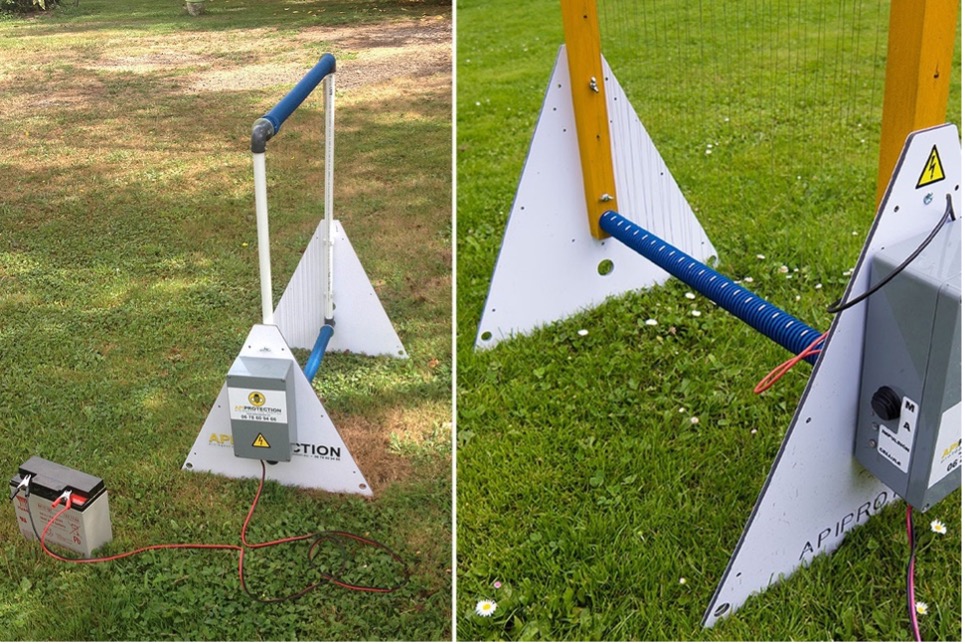
When hornets become overwhelmingly numerous or when beekeepers need an immediate solution during inspections, paddles, both manual and electric, come to the rescue. The traditional paddle or racket can be manually swung with skill and precision to swat hornets out of the air. For an added punch, the electric variant serves as a hand-held electrified racket, allowing beekeepers to zap hornets on the spot. Both versions are reactive methods, best used in combination with other preventive measures.

Additional notes:
Understanding the life cycle of the Yellow-legged hornet in your specific region is fundamental, as this cycle is influenced heavily by the local climate. It’s crucial to initiate trapping early in the spring and to persist until the later parts of fall. Be aware that hornets might continue their bee pursuits even into October or November, depending on the region. The months mentioned here are based on our experience in France. Naturally, if you reside in Florida or North Dakota, you might observe entirely different patterns.
Environmental consciousness is paramount. While combatting the hornet menace, we must also be judicious in minimizing our impact on the broader ecosystem. As a recommendation, set up traps near identified nests or in locales where hornet activity has been observed. If, after a few days, your traps remain empty, consider relocating them just a short distance away. This subtle shift might make all the difference.
The potency of your attractant solution can wane over time. Ensure that you refresh the mixture roughly every three weeks. It’s worth noting that extremely cold temperatures might inhibit the effectiveness of your attractant.
In summation, finding the perfect trapping strategy might entail a bit of trial and error. However, there’s an advantage at hand: learning from the experiences and insights of French beekeepers. This wealth of knowledge provides a significant leg up in tackling the Asian hornet challenge.
Interested in delving deeper into effective trapping methods? Head over to our VespaCatch page for a comprehensive look at how this trap can be your frontline defense against this winged menace. Spoiler alert: our team is working on a new selective trap, available in 2024. Stay tuned!
And don’t miss out: our upcoming and final article in this series will guide you through nest detection and eradication. Together, with knowledge and action, we can protect our buzzing allies!
 by Véto-pharma
by Véto-pharma  by Véto-pharma
by Véto-pharma Join the Véto-pharma community and receive our quarterly newsletter as well as our occasional beekeeping news. You can unsubscribe at any time if our content does not suit you, and your data will never be transferred to a third party!
© 2019-2025, Véto-pharma. All rights reserved